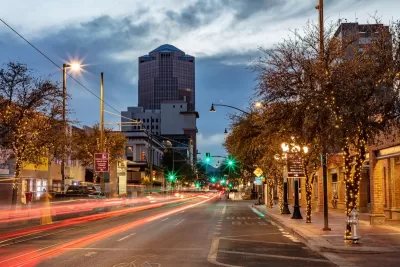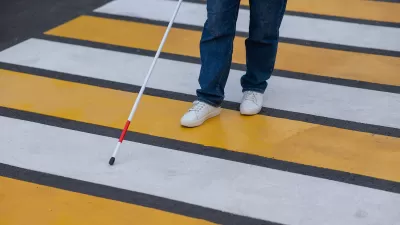In many cases, it’s impossible to prioritize the safety of pedestrians and other vulnerable road users without sacrificing some speed.

This evening, I’m writing from a house built at the turn of the last century when Tucson was a booming railroad town. It’s less than two hundred yards from the old railroad yard, where you can still see the tracks in the gravel next to one of Tucson’s many bike paths.
It’s a beautiful early spring desert evening, but I have the doors and windows closed because I’m also within a few hundred yards of Interstate 10, the major north-south highway connecting Phoenix to Tucson and continuing on to the Mexican border. The roar of the highway is like a geolocator; you know you’re in a community that was, at least historically, poor and nonwhite.
The irony of this neighborhood, Barrio Viejo, is that its houses now sell for millions of dollars. Everyone loves the narrow, walkable streets and the lack of setbacks. But when the freeway was built, this was considered a slum. Much of the neighborhood was bulldozed for a convention center, which became outdated and has now been bulldozed as well.

But Tucson has not learned anything from what happens when you raze communities to expand roads for cars. Just to the east of me, a giant widening project on Broadway completed in 2023 expanded this crosstown road from four to six lanes. Also completed that year: the “Downtown Bypass,” an urban highway envisioned in the 1980s to connect the Davis-Monthan Air Force Base directly to I-10.
Tucson was the first place I visited outside of NYC that I really, really wanted to move to. I felt, with its network of bike trails and bikeable climate, that Tucson was a place I could see myself living without being able to drive. But my love for the desert, the community, and the miles and miles of bike paths is mitigated by the fear I feel as a nondriver, especially as I started biking and walking the city with my kid.
When I moved to Tucson, I started volunteering with the advocacy group Living Streets Alliance and produced videos about their Complete Streets campaign, Ciclovias, and the pedestrian safety crisis. On a particularly awful day, which also happened to be my birthday, I went out to film a vigil for a mom and child who had been killed crossing Pima Road, one of these awful, high-speed arterials that form a grid of death across the city.
As a nondriver in Tucson, you might be able to walk around your neighborhood and enjoy the speckled shade of palo verde trees and quiet streets, but you’ll eventuallyhave to cross one of these sun-baked, multi-lane 'stroads.’ If you aren’t strategic, you might have to dash across, as the signals are often far apart. This ensures that cars can travel as quickly as possible, but means long detours for people walking or biking.
The intersection where the mother and child were killed didn’t have a stoplight. As the vigil ended, I had to cross back to the other side to head home. I hesitated. Should I walk half a mile down the road out of my way to the nearest intersection with a signal? Or should I risk it and try to dash across between gaps in the speeding cars? I was tired. I decided to risk it. It’s a choice I’ve made a million times now as a parent when the kid is whining, hungry, and has to pee.
In Smart Growth America’s 2024 Dangerous by Design report, Tucson was named the third most dangerous metro area in the nation, and pedestrian deaths have continued to rise in Tucson and across the country. According to the report, 2022 (the most recent year with complete federal data) marked a 40-year high in deaths of people struck and killed while walking. (Editor’s note: traffic deaths began a downward trend in 2023 after spiking sharply during the pandemic.)
My family left Tucson in 2018, moving back to Washington State to be closer to our extended families. While family was the main pull, I was also pushed by Tucson’s dubious distinction as one of the most dangerous cities in the United States to be a pedestrian.
As communities across the country struggle with pedestrian safety, when even states that follow Vision Zero best practices continue to see deadly crash rates increase, it’s time to question whether we are actually going to be able to reduce deaths and serious injury by continuing our current approach.
In countless conversations about everything from municipal budget priorities to the design of interstate bridge replacement projects, I hear engineers and planners emphasize how they plan to “prioritize all modes.”
Widening a highway and adding sidewalks and a bike lane? That’s “Prioritizing All Modes.” Adding “intelligent signals” that will try to maximize vehicle throughput and reduce delays (for drivers): “Prioritizing All Modes.” Building a pedestrian bridge over a highway and adding benches and art? Definitely “Prioritizing All Modes.”
It is not possible to prioritize everyone.
Every decision has tradeoffs, and it’s clear who those choices prioritize when you consider the comfort, ease, and safety of different users. When it’s faster, easier, safer, and more comfortable to get somewhere by driving, we are prioritizing driving.
Very few elected leaders are willing to say they want to slow down car travel and make transit more convenient than driving. Yet unless we have leaders who are willing to do this, cars will continue to kill too many.
Making roads safer for people outside of vehicles necessitates making vehicles go slower. Cars kill because they are heavy and fast, and even the slightest mistake can have horrific outcomes. At slower speeds, they are less lethal, and at slower speeds, the time savings of car travel over other modes decreases.
Slower vehicles require a conversation about land use, zoning, and housing. When more affordable housing can only be built twenty miles outside of town, we are building ourselves into decades of increased traffic deaths.
We need to build communities where more people can travel by car less far, less fast, less often. When it is necessary to travel farther, we need to make driving a less convenient option than riding public transit.
This approach is very explicitly not “Prioritizing All Modes.” It is prioritizing the movement of people outside of vehicles over the movement of people in vehicles. It is prioritizing the movement of transit over the movement of cars.
To get to this point, we need coalitions big enough to insist that it’s possible to deprioritize car speed. Let’s start with the one-third of people living in the United States who can’t drive because of disability, age, or income. Because we’re lower-income, youth, nondriving seniors, and disabled people and more likely to be from Black, Brown, immigrant, and tribal communities, our mobility needs as nondrivers aren’t given as much weight. We need to change that and insist on being visible. And we need to make it clear that it’s impossible to build a safe and inclusive transportation system without deprioritizing the fast, seamless movement of cars.
Anna Zivarts is a low-vision parent, nondriver and author of When Driving Is Not an Option: Steering Away from Car Dependency (Island Press, 2024). Anna launched the Week Without Driving challenge at directs the Disability Mobility Initiative at Disability Rights Washington, where she organizes to bring the voices of nondrivers to the planning and policy-making tables.

Walkable Density: Building Livable, Equitable, and Resilient Communities

Planetizen Federal Action Tracker
A weekly monitor of how Trump’s orders and actions are impacting planners and planning in America.

Map: Where Senate Republicans Want to Sell Your Public Lands
For public land advocates, the Senate Republicans’ proposal to sell millions of acres of public land in the West is “the biggest fight of their careers.”

Restaurant Patios Were a Pandemic Win — Why Were They so Hard to Keep?
Social distancing requirements and changes in travel patterns prompted cities to pilot new uses for street and sidewalk space. Then it got complicated.

Platform Pilsner: Vancouver Transit Agency Releases... a Beer?
TransLink will receive a portion of every sale of the four-pack.

Toronto Weighs Cheaper Transit, Parking Hikes for Major Events
Special event rates would take effect during large festivals, sports games and concerts to ‘discourage driving, manage congestion and free up space for transit.”

Berlin to Consider Car-Free Zone Larger Than Manhattan
The area bound by the 22-mile Ringbahn would still allow 12 uses of a private automobile per year per person, and several other exemptions.
Urban Design for Planners 1: Software Tools
This six-course series explores essential urban design concepts using open source software and equips planners with the tools they need to participate fully in the urban design process.
Planning for Universal Design
Learn the tools for implementing Universal Design in planning regulations.
Heyer Gruel & Associates PA
JM Goldson LLC
Custer County Colorado
City of Camden Redevelopment Agency
City of Astoria
Transportation Research & Education Center (TREC) at Portland State University
Camden Redevelopment Agency
City of Claremont
Municipality of Princeton (NJ)





























